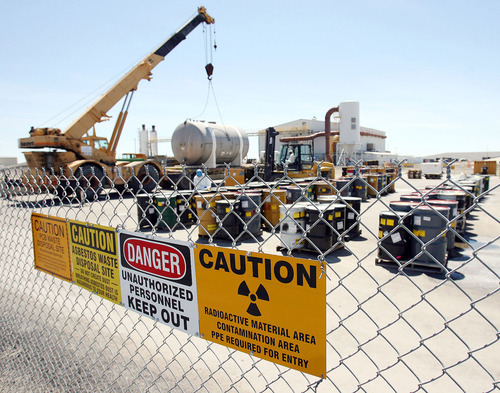This is an archived article that was published on sltrib.com in 2011, and information in the article may be outdated. It is provided only for personal research purposes and may not be reprinted.
State regulators appear poised to sign off on a request from EnergySolutions to allow "down-blended" waste from nuclear reactors to be buried at the company's Tooele County radioactive landfill, says an environmental group.
Christopher Thomas, director of the Healthy Environment Alliance of Utah (HEAL), said in a meeting last week with the staff of the Utah Division of Radiation Control he gathered that regulators agree with the company that no further in-depth review of blending is needed on the controversial practice.
Rusty Lundberg, director of the Utah Division of Radiation Control, said only that his staff has mostly finished its review of the company's request to allow blended waste without a "site performance assessment," and the staff conclusions will be discussed at a stakeholder meeting set for Tuesday.
Although he declined to release the findings Monday, he noted: "There are some aspects of the information [on blending from EnergySolutions] that we are in agreement with."
If Lundberg does sign off on down-blending without requiring an additional review, it will be a victory for the Salt Lake City nuclear cleanup company, which has been saying for more than a year that its low-level radioactive disposal site is up to the task of containing blended waste and that an existing performance assessment already addresses any concerns.
But HEAL said the prospect of more blended waste should be the subject of a more focused study of the Tooele County site to address the long-term safety and health questions raised by federal regulators and the state Radiation Control Board. In addition, said Thomas, blending will allow the company and its customers, in effect, to bury waste more hazardous than the Class A waste currently allowed in the state.
"It circumvents the state's ban on Class B and C waste, which has been in place for years," said Thomas.
He added that one analysis estimated the radioactivity at the EnergySolutions site would increase eight-fold if blended waste is permitted.
The radiation board approved a new regulation this year to require EnergySolutions to take a closer look any time it wants to accept radioactive waste types that were not part of a generic review done more than 30 years ago by the U.S. Nuclear Regulatory Commission. Performance assessments such as these are intended to make sure the hazards will stay on site and not harm people or the environment in the long run, and they will be part of updated federal regulations that are being developed now in Washington.
Peter Jenkins, chairman of the radiation board, said board members have not been informed of any decision on blended waste.
"Certainly, we want to learn why [the DRC staff aides] made the decision they made and the justification for it," Jenkins said.
EnergySolutions has accepted small amounts of blended waste over the years. But it hopes to tap into a new market by offering waste blending services for nuclear power companies that periodically have to dispose of ion-exchange resins from their reactors.
The service, part of a joint venture with the U.S. arm of the Swedish company Studsvik, mixes together higher radiation resins that would ordinarily be banned from Utah under a 2005 law with resins that fall well within the state's radiation limits. The resulting blended waste also falls within the state's radiation-hazard limits, although the radiation-board has publicly opposed down-blending if it is done expressly to get under the state limit.
For three years, most reactor operators have had no disposal for their more hazardous resin waste. But with the imminent opening of a full-service radioactive waste disposal site in Texas, that waste will no longer be orphaned.
Janet Jensen, a Utah lawyer who represents Waste Control Specialists, the operator of the Texas site, said she will be on-hand for the Tuesday stakeholder meeting. She noted there is no reason for Utah to make room for blended waste, since there is now another option.
"They are better prepared to take it," she said of the Texas site.
Coming up Stakeholder meeting
P The Utah Division of Radiation Control hosts the next EnergySolutions Environmental Issues Stakeholder Forum.
When • 4 p.m Tuesday
Where • DEQ Board Room, 195 N. 1950 West, Salt Lake City



